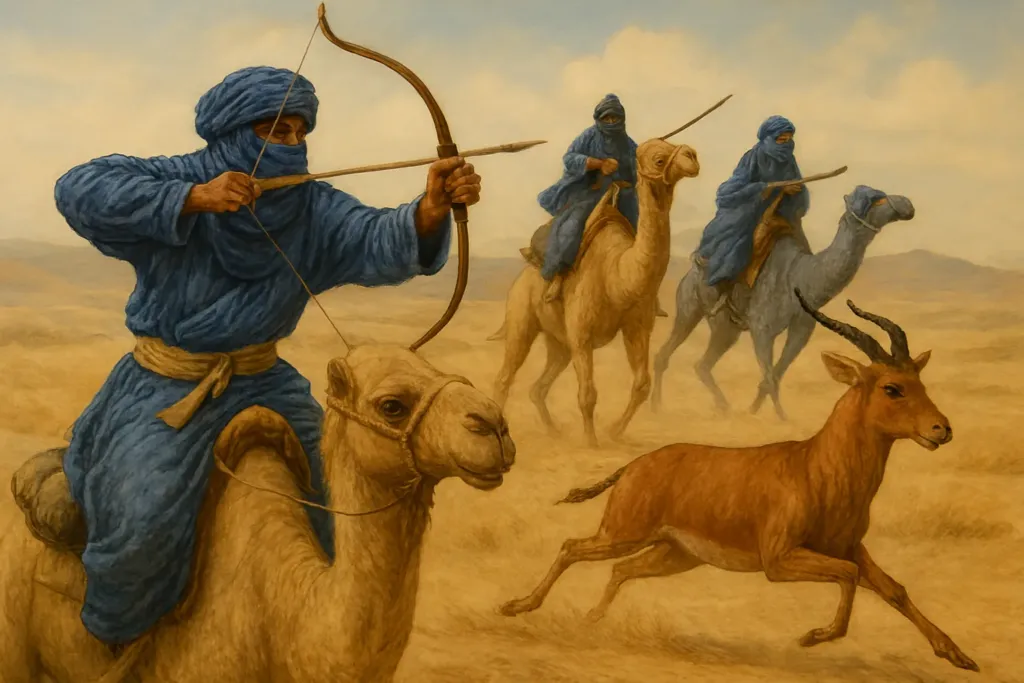The Tuareg speak Tamahaq/Tamasheq and write in Tifinagh; most are Sunni Muslims with local traditions of piety. Hospitality, mutual aid, and honor structure social life. Stereotypes about “aggressiveness” or “friendliness” are misleading: norms emphasize dignity and fairness; violence is condemned outside self-defense or honor disputes. Alcohol and drugs are generally avoided for religious reasons. Riding, camel racing, wrestling, and marksmanship are common pursuits. Social organization features confederations and clans with occupational strata; councils of elders and notable lineages arbitrate decisions.
History
Ethnogenesis is linked to Amazigh communities of North Africa and desert centers like Fezzan and Hoggar. In the medieval era, Tuareg controlled segments of trans-Saharan trade (salt, gold, caravan guidance) and key oases. Colonial conquest disrupted confederational autonomy and routes; the 1970s–1980s droughts devastated pastures. In the postcolonial period, communities were split by borders of Algeria, Libya, Mali, Niger, Burkina Faso, etc., engaging in negotiations and conflicts over representation, security, and resource access.
Name
The exonym “Tuareg/Touareg” is often linked to the toponym Targa (Fezzan) and Arabic forms. Endonyms include Imuhagh/Imushagh (north), Imajeghen (south), and Kel Tamasheq (“people of Tamasheq”). Variation reflects dialect diversity and Arabic/European orthographies.
Livelihoods
Traditional livelihoods include camel pastoralism, small livestock herding, caravan trade, and crafts (leather, silver). Southern fringes practice seasonal farming and haulage. Today many combine mobile herding with urban wage work, craft tourism, music, and entrepreneurship; mobile networks adapt to borders and digital communication.
Physical description
As part of the Amazigh complex, Tuareg ancestry is layered across the Sahara–Sahel; phenotypes range widely in skin tone, features, and stature. A hallmark is the men’s indigo tagelmust (litham) for sand and sun protection and status signaling. Women wear distinctive silver jewelry and patterned fabrics; urban styles blend tradition and modernity.
Distribution
Historic and modern range: southern Algeria (Hoggar), southwest Libya, northern Mali (Ifoghas, Timbuktu), northern Niger (Agadez, Air), northern Burkina Faso, and border areas of Nigeria and Chad; diasporas live in Maghreb and European cities. Confederations include Hoggar, Ajjer, Asben (Air), Ifoghas, and Iwellemmeden.
Wars and conflicts
Colonial campaigns met resistance and treaties. In independent states, Tuareg rebellions and peace accords occurred in Mali and Niger (late 20th–early 21st centuries), alongside shifting armed groups during regional crises. Drivers include drought, peripheral marginalization, and competition over routes; intra-community lines—clan and regional—sometimes complicate negotiations.
Population
Current estimates total about 3–4 million across the region, largest in Niger and Mali, with significant groups in Algeria and Libya. Recent decades show moderate growth due to high fertility and urbanization, with local declines from migration, drought, and conflict. Accurate counts are difficult given mobility and divergent census methods.
Traditions, rites, holidays
The hospitality code includes the “three cups of tea,” rules for hosting travelers, and respect for elders. Poetry, the imzad (one-string fiddle), and the tende drum animate festivals and improvised contests; marriages are negotiated with kin participation. Funerals follow Islamic norms, though ancient markers and tumuli dot the landscape; the calendar aligns with Islamic feasts and seasonal moves.
Myths and legends
Oral tradition preserves clan genealogies, tales of caravan heroes and “seas of sand,” the founding legend of Tin Hinan in Hoggar, and parables on honest trade and the dignity of free people. Poetry functions as chronicle and court of honor.
Notability
Musicians Tinariwen, Bombino, Mdou Moctar, and Tartit brought “desert blues” to global stages. Public figure and aviator Mano Dayak advocated Air communities; poet-artist Hawad advances contemporary Tuareg poetics. Charles de Foucauld compiled Tamahaq dictionaries; Tuareg appear across film, photography, and reportage on the Sahara.
Food
Staples include millet, couscous, dates, goat and camel milk, festive meat, and sweet mint tea. Oases provide vegetables and fruit; on the move, dried meat and flatbreads baked on hot sand or stone.
Clothing
The tagelmust and flowing darraa/boubou protect against sun and wind; indigo dyes may tint fabric and skin. Women combine light fabrics with silver amulets; footwear is leather sandals. Contemporary dress spans traditional to urban casual.
Tourism
Popular routes: Hoggar and Tassili n’Ajjer (Algeria), the Air Mountains and Agadez (Niger), Timbuktu and Adrar des Ifoghas (Mali), and central Saharan oases. Family guide networks host travelers for camel treks and craft markets; small museums and cultural centers operate locally.
Interaction tips for visitors
Dress modestly and accept offered tea as a sign of respect. Ask permission before photos, especially of women and sacred spaces; use the right hand when giving or receiving. Avoid pressing on politics or inter-clan matters; bargaining is welcome when done calmly and courteously.
- Great Plains (USA)
- Tonga
- Bali
- Cod Wars
- Belarus
- Sumatra
- History, discovery and scientific significance of the McMurdo Dry Valleys
- Lofoten Islands
- Distant Storms Create Dangerous Surf at East Coast Beaches
- Cuba
- Namaqualand Flower Route
- Nicaragua
- Paradise for Sea Lovers: World Regions with the Most Swimming Beaches
- Alaska
- The World of Varans
- From trauma healers to in-house psychologists, hotels are increasingly catering to travellers’ mental health
- Zulfiqar: The Legendary Sword and a Tourist Symbol of the Islamic World
- Colombia
- Dagestan: between the grandeur of nature and the challenges of tourism
- 9 Reasons Why People Love to Travel to Other Countries











